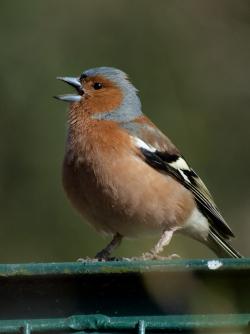As one species of European songbird island-hopped to colonize mid-Atlantic archipelagoes over the course of a half million years, their songs lost their sense of syntax.
Chaffinches (Fringilla coelebs) on the furthest island of their dispersal, Gran Canaria in the Canary Islands, still sing the same notes, but with a much less structured pattern from one bird to the next, sort of like an island of Charlie Parkers.
“A chaffinch from mainland Europe always sounds like a chaffinch from mainland Europe,” said biologist Robert F. Lachlan who completed the 15-year study of chaffinch song structure during a post-doctoral fellowship at Duke University. But on Gran Canaria, it’s much harder for a human to pick them out by hearing alone, he said.
Lachlan recorded the songs of 723 males in 12 different populations across the European mainland, the Azores and the Canary Islands and compared them computationally. Subunits of the songs, which he calls syllables, differed slightly between populations, but the sequencing of the syllables — the syntax — was progressively less predictable the further the birds got out on the chain of colonization.
The work appears Oct. 7 in the journal Current Biology. It was funded by the Dutch Science Foundation and Duke University.
Syntactical structure was lost in a step-wise fashion that matches the known dispersal of the species across these islands. At the end of the island chain, “the syntax isn’t just changing, it’s disappearing,” Lachlan said. “It’s not about changing the rules, it’s about losing them.”
Lachlan says one factor in the loss may have been that island birds face fewer competing species. Whereas a female chaffinch might be trying to pick out the right male among 60 other songbird species singing all at once in Europe; in the Azores, she faces just eight other songbirds. The males are the singers. “One of the jobs the female has is to identify her own species.”
Unfortunately the data don’t completely match that idea, Lachlan said. There are almost twice as many species on the Canary Islands as on the Azores, yet the Canary Island songs have much less structure. “Other factors must also be involved,” Lachlan said.
A large body of research has shown that birds learn their species-specific song from their elders. If cultural transmission were the only source of syntactical structure in the songs, however, one would expect songs from the smaller island populations to have more structure than those from the mainland not less, Lachlan said.
But there is also a genetic component to that learning. Hundreds of genes have been identified which relate to song learning and singing. Studies show that young birds have a genetic predisposition that helps them pick out which songs they ought to be learning in order to develop species-typical songs.
“It seems very likely that what we measured is the result of the evolution of such genes,” Lachlan said.
One of two plausible explanations for the loss of syntactical structure may be something called a “cultural trap,” Lachlan said. “In small populations, like those on islands shortly after colonization, an evolutionary interaction between culture and genetic predisposition favors individuals that can recognize and learn a wider range of songs – in this case, a wider range of syntactical patterns.”
It may also be a case of “withdrawal of learning,” he said. When populations are very small on the new island, young birds may find few tutors to learn from. Some of the young birds would be forced to improvise, and this would introduce new songs into the population at a higher rate than normal, leading to rapid change in song structure.
Now that he has established this pattern of syntactical loss across the islands, Lachlan hopes to use it to investigate the causes of song learning evolution.
If our reporting has informed or inspired you, please consider making a donation. Every contribution, no matter the size, empowers us to continue delivering accurate, engaging, and trustworthy science and medical news. Independent journalism requires time, effort, and resources—your support ensures we can keep uncovering the stories that matter most to you.
Join us in making knowledge accessible and impactful. Thank you for standing with us!

